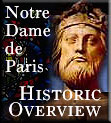

Gothic Decoration and Motif of Churches,
Cathedrals and Monasteries :
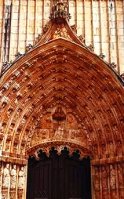
Image at right : Portal archivolt at the Monastery of Batalha, Portugal.
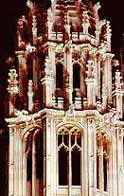
Image at right : Spire crockets in the English Neo-Gothic style.
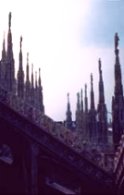
Image at right : Finial details at Milan cathedral, Italy.
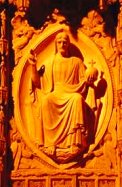
Image at right : The figure of Christ within a Vesica Pisces motif; Washington national cathedral, U.S.A.
“To the Middle Ages art was didactic. All that it was necessary that men should know—the history of the world from the creation, the dogmas of religion, the examples of the saints, the hierarchy of the virtues, the range of the sciences, arts and crafts—all these were taught them by the windows of the church or by the statues in the porch.
 The pathetic name of Biblia pauperum given by the printers of the fifteenth century to one of their earliest books, might well have been given to the church. There the simple, the ignorant, all who were named “sancta plebs Dei,” learned through their eyes almost all they knew of their faith. Its great figures, so spiritual in conception, seemed to bear speaking witness to the truth of the Church's teaching. The countless statues, disposed in scholarly design, were a symbol of the marvellous order that through the genius of St. Thomas Aquinas reigned in the world of thought. Through the medium of art the highest conceptions of theologian and scholar penetrated to some extent the minds of even the humblest of the people.
The pathetic name of Biblia pauperum given by the printers of the fifteenth century to one of their earliest books, might well have been given to the church. There the simple, the ignorant, all who were named “sancta plebs Dei,” learned through their eyes almost all they knew of their faith. Its great figures, so spiritual in conception, seemed to bear speaking witness to the truth of the Church's teaching. The countless statues, disposed in scholarly design, were a symbol of the marvellous order that through the genius of St. Thomas Aquinas reigned in the world of thought. Through the medium of art the highest conceptions of theologian and scholar penetrated to some extent the minds of even the humblest of the people.
But the meaning of these profound works gradually became obscure. New generations, with a different conception of the world, no longer understood them, and from the second half of the sixteenth century mediaeval art became an enigma. Symbolism, the soul of Gothic art, was dead.
The Church was ashamed of the once beloved legends, in which for so many centuries Christianity had been nurtured. The council of Trent marks the end of the old artistic tradition, and we know from a book full of the spirit of the council, that the writer—Molanus the theologian—had lost the key to the art of the Middle Ages.”
—Emile Mâle,The Gothic Image - Religious Art in France of the Thirteenth Century, 1913
“We are reminded that after all we must of necessity look on the great churches of the Middle Age with other eyes than those who built or first worshipped in them; that there is something verily worth having, and a just equivalent for something else lost, in the mere effect of time, and that the salt of all aesthetic study is in the question,—What, precisely what, is this to me? You and I, perhaps, should not care much for the mural colouring of a medieval church, could we see it as it was; might think it crude, and in the way. What little remains of it at Amiens has parted, indeed, in the course of ages, with its shrillness and its coarse grain. And in this matter certainly, in view of Gothic polychrome, our difference from the people of the thirteenth century is radical. We have, as it was very unlikely they should have, a curiosity, a very pleasurable curiosity, in the mere working of the stone they built with, and in the minute facts of their construction, which their colouring, and the layer of plaster it involved, disguised or hid. We may think that in architecture stone is the most beautiful of all things. Modern hands have replaced the colour on some of the tombs here—the effigies, the tabernacles above—skilfully as may be, and have but deprived them of their dignity. Medieval colouring, in fact, must have improved steadily, as it decayed, almost till there came to be no question of colour at all. In architecture, close as it is to men's lives and their history, the visible result of time is a large factor in the realised aesthetic value, and what a true architect will in due measure always trust to.”
—Walter Pater, Notre-Dame d'Amiens, 1894“Alone at some distance from the wasting walls of a disused abbey I found half sunken in the grass the grey and goggle-eyed visage of one of those graven monsters that made the ornamental water-spouts in the cathedrals of the Middle Ages. It lay there, scoured by ancient rains or striped by recent fungus, but still looking like the head of some huge dragon slain by a primeval hero. And as I looked at it, I thought of the meaning of the grotesque, and passed into some symbolic reverie of the three great stages of art.
The Old Greeks summoned godlike things to worship their god. The medieval Christians summoned all things to worship theirs, dwarfs and pelicans, monkeys and madmen. The modern realists summon all these million creatures to worship their god; and then have no god for them to worship. Paganism was in art a pure beauty; that was the dawn. Christianity was a beauty created by controlling a million monsters of ugliness; and that in my belief was the zenith and the noon. Modern art and science practically mean having the million monsters and being unable to control them; and I will venture to call that the disruption and the decay.”
—G. K. Chesterton,On Gargoyles, 1909
Bibliography
Matthew Holbeche Bloxam, London, D. Bogue (1846)
Eugène Viollet-le-Duc, Paris (1858-68)
Development & Production Credits
Primary Text : Rhey Cedron — Theme Editor : Nicole MarchStructural Design & Project Direction : Rhey Cedron
Art Direction : Rhey Cedron — Art Production : Mark Nelson & Ash' Murti
Artistic Consultant : Thierry Alberto
Art Research : Malcolm Hurrell — Support Research : Walter McCrae
(Life) Support Production : Henry Craig, Joan Flandrin, Clara Kelly and
a Patient Legion of Friends, Family & Angels
cultural projects. Ask to receive your free newsletter
Your questions or comments are always welcome!
Gothic Dreams E-mail
Individual use of enclosed material is encouraged for the purposes of education and enjoyment.
The republication of textual or graphic content, without license, is an infringement of Copyright laws.

